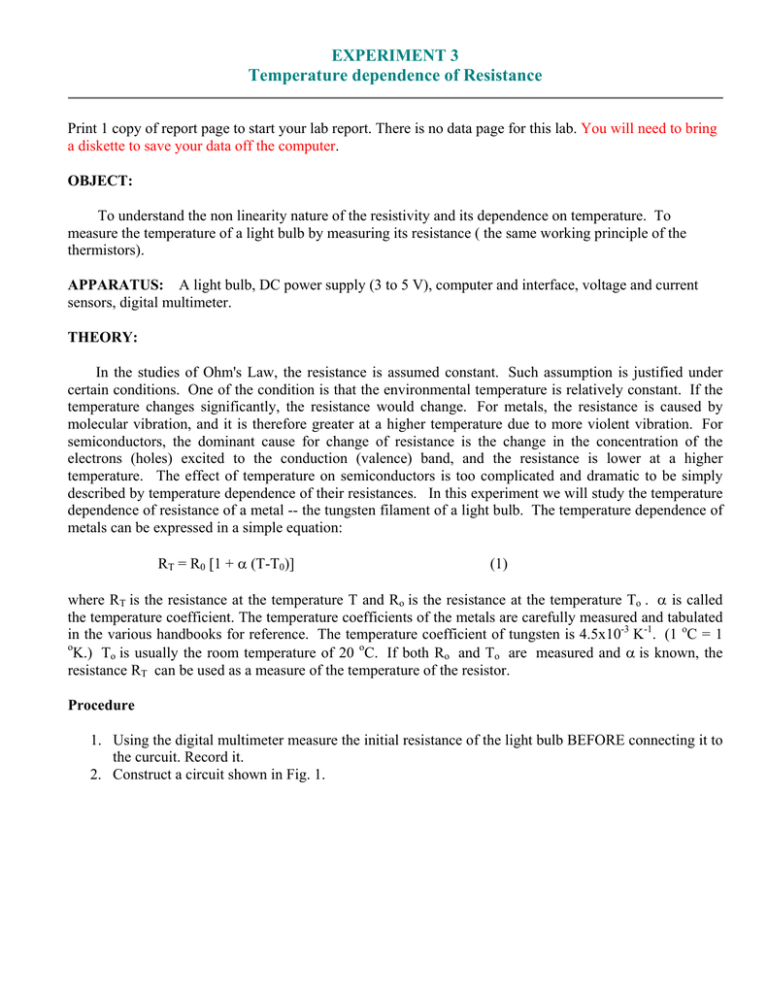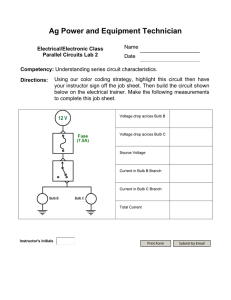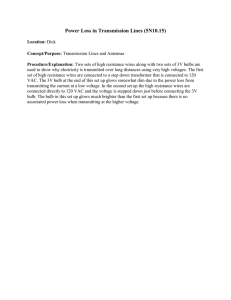281 Lab 1Temp Dep Res Handout
advertisement

EXPERIMENT 3 Temperature dependence of Resistance Print 1 copy of report page to start your lab report. There is no data page for this lab. You will need to bring a diskette to save your data off the computer. OBJECT: To understand the non linearity nature of the resistivity and its dependence on temperature. To measure the temperature of a light bulb by measuring its resistance ( the same working principle of the thermistors). APPARATUS: A light bulb, DC power supply (3 to 5 V), computer and interface, voltage and current sensors, digital multimeter. THEORY: In the studies of Ohm's Law, the resistance is assumed constant. Such assumption is justified under certain conditions. One of the condition is that the environmental temperature is relatively constant. If the temperature changes significantly, the resistance would change. For metals, the resistance is caused by molecular vibration, and it is therefore greater at a higher temperature due to more violent vibration. For semiconductors, the dominant cause for change of resistance is the change in the concentration of the electrons (holes) excited to the conduction (valence) band, and the resistance is lower at a higher temperature. The effect of temperature on semiconductors is too complicated and dramatic to be simply described by temperature dependence of their resistances. In this experiment we will study the temperature dependence of resistance of a metal -- the tungsten filament of a light bulb. The temperature dependence of metals can be expressed in a simple equation: RT = R0 [1 + α (T-T0)] (1) where RT is the resistance at the temperature T and Ro is the resistance at the temperature To . α is called the temperature coefficient. The temperature coefficients of the metals are carefully measured and tabulated in the various handbooks for reference. The temperature coefficient of tungsten is 4.5x10-3 K-1. (1 oC = 1 o K.) To is usually the room temperature of 20 oC. If both Ro and To are measured and α is known, the resistance RT can be used as a measure of the temperature of the resistor. Procedure 1. Using the digital multimeter measure the initial resistance of the light bulb BEFORE connecting it to the curcuit. Record it. 2. Construct a circuit shown in Fig. 1. To interface mA 4.5V R V To interface Figure 1. 3. Switch on the battery and adjust the voltage to about 0.1 V. Measure the current and the voltage across the bulb R with the voltage and current sensors interfaced to a computer. Then increase the voltage by 0.1 V and take another data point. Repeat the measurement until the voltage reached (but do not exceed) 5 V. You should have 10-15 data points. 4. Plot the voltage versus the current using computer. You should get a smooth non linear curve. Try to fit the curve with a quadratic or exponential functions. Import your graph and the data table into a PowerPoint page (CTRL+Print Screen, then paste), and print the page (add your and your partner's names). Report this function and include the plot in your data analysis. Highlight the data in the table and copy them to an EXCEL file. Put the initial resistance from step 1 into the same file. Save the file on your diskette. DATA ANALYSIS: 1. Open your EXCEL file. In the next column of your data table calculate resistances of all the data points. Plot the resistances versus the current. 2. In the next column of your data table calculate the temperatures of all the data points, using Eg. (1). The temperature coefficient of tungsten is 4.5x10-3 K-1. Assume the initial temperature To = 20 oC. You should be getting reasonable estimate of the working temperature when the bulb glows. Plot the resistance versus the temperature. Fit it to a linear function. Include the plot in your data analysis. 3. Answer the question: The initial temperature is not really known. We assume To = 20 oC. How much would the assumed initial temperature affect your estimate of the final temperature of the filament if the initial temperature is, say, 100 oC instead ? 4. Make conclusion about your findings. Reminder: Check you math, check the units, check the rounding, do not forget to follow the format for your lab report (see syllabus).



